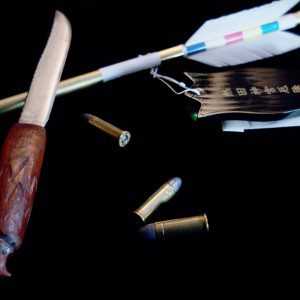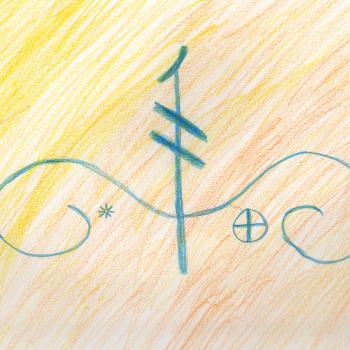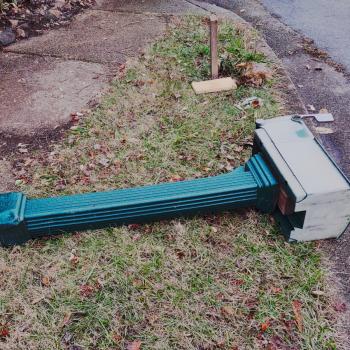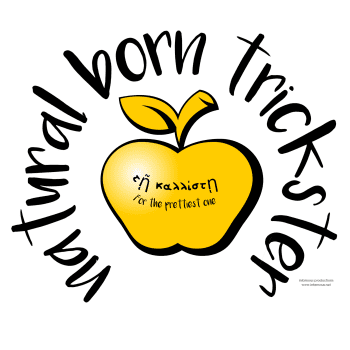It is always going out on a limb to generalize, but I’m going to take that risk here: Pagans like swords and knives.
The athame is standard issue for our Wiccan contingent, of course, and so large public rituals often feature an officiant wielding something metallic, sharp, and pointy. I’m not Wiccan but I once danced around waving a (borrowed) sword in such a ritual. (Bodypaint, a sarong, and a sword…it was interesting.) Vendors sell knifes, and even swords, at events like Starwood and the Free Spirit Gathering.
Heck, the traditional Tarot, a Pagan favorite, has a whole suit dedicated to swords.
And Buddhism, while it is often thought of as a pacifist path, has plenty of swords in its iconography. Bodhisattvas and deities like Manjusri and Acala are shown wielding them, and Zen’s association with the warrior caste in Japan only strengthened the link.
So placing a blade on an altar or otherwise bringing one into a ritual context is unlikely to cause much consternation.
Bullets, on the other hand…you’ll find more varied opinions about those.
My blogging colleague and neighbor Asa West recently wrote critically about the idea of making offerings of bullets to the Morrigan. I don’t know the details of the case and I can’t speak about worship of the Morrigan; she is one of those deities who has looked at me and nodded but not (yet) called my name.
But I’d like to consider the general idea of bullets and firearms as objects of spiritual import. Asa is not happy at the idea, asking “If a bullet is okay, why not a landmine? Or napalm? Or a nuclear warhead?”
There is a very large difference. A firearm is a weapon of individual use against another individual, with all of the moral choice and agency that implies. It is not a device of mass destruction. It is more like the sword, or the bow, than the bomb.
Let’s start with a clear look at the sword. Our subculture has a certain romanticism about knives and swords, of which we need to beware. There is a strong argument that the ancient sword was a brutal thing, much more a tool of oppression than of spirituality. (Not to rain on anyone’s parade. I still enjoyed that fencing class I took years ago and want to study more sword arts.)
The Roman Empire, the people who gave us the word “decimate”, managed to conduct mass murder and colonial oppression quite effectively with swords and spears. If one’s victims are not as well armed, bladed weapons are highly effective weapons of massacre.
 And this is not just ancient history: the machete was the favored weapon in the Rwandan Genocide[“1 million killed”; Braid] and just a few years ago was used to kill hundreds at a time in fighting between Christians and Muslims in Nigeria.[“Machete-wielding rioters kill 200”]. Even in the contemporary U.S., despite the easy availability of firearms, 13% of homicides use knifes.[FBI]
And this is not just ancient history: the machete was the favored weapon in the Rwandan Genocide[“1 million killed”; Braid] and just a few years ago was used to kill hundreds at a time in fighting between Christians and Muslims in Nigeria.[“Machete-wielding rioters kill 200”]. Even in the contemporary U.S., despite the easy availability of firearms, 13% of homicides use knifes.[FBI]
Today the machete may be the weapon of a rioting mob, but before the industrial age and cheap steel, an average peasant could not afford a sword. A typical peasant conscript would be armed with a spear, or even with a farm implement.
In classical and medieval times the sword was the weapon of the professional soldier or the aristocrat. It was the tool of the feudal enforcer (the Eurpoean knight, the Japanese samurai), the imperial occupier (the Roman legionary), or perhaps the aristocrat (the wealthy Viking warrior, the European gentleman with his rapier). It was a profoundly anti-democratic implement.
Let’s contrast this with the bow and arrow. The bow is prehistoric in origin; we don’t know when it was first used as a weapon of war rather then a hunting implement but it was at least several thousand of years ago.
And so like the sword, it makes its appearances in mythology and ritual. Apollo was the god of archery, the hero Odysseus was recognized by his ability with the bow, and we have Sagittarius the Archer in the Zodiac. In Tibet the dadar arrow is an important ritual tool.[Bellezza] In Japan, people go to their local Shinto shrine during the New Year holiday to obtain a hama-ya, a “demon-breaking arrow” displayed to ward off misfortune.[Suzuki]
The use of the bow as a weapon of war rose and fell over the centuries as tactics and arms and armor changed. But wood for a bow is a lot easier to come by than bronze, iron, or steel for a sword, and arrowheads don’t take much metal — or can even be made from stone, or the wood of the arrow itself. So the bow and arrow could be more commonly available.
Probably the bow was used by commoners mostly as a hunting implement. But as a weapon it was more accessible to the people than the sword. The English longbow, in particular, was used by Welsh fighters resisting the Anglo-Norman invasion, and it took enough of a toll that the English adopted it. A citizenry skilled in archery was so important to the English rulers that in 1363 a law was passed requiring men to practice archery on Sunday and holidays.[“The Longbow” ] (While not enforced, that law is apparently still on the books.[“Wiltshire vicar”])
Experts still debate how well a clothyard shaft from a longbow could penetrate armor, but it was not a trivial threat. This empowerment of commoners made life interesting for the nobility. As sociologist Stanislav Andreski noted, “Unlike their counterparts in France and Germany the English peasants were not helpless against their lords….It was surely not accidental that the only peasant revolt in England which succeeded took place at the time of the predominance of the long bow.”.[Andrzejewski, 65]
So while the sword was an instrument of feudalism, the longbow helped pave the way for the idea of the “rights of Englishmen”. We can see echos of this idea of the bow as democratizing force in folklore from Robin Hood to The Hunger Games.
It’s worth noting that the bow is still being used in 21st century Africa both as a weapon of resistance and of aggressive violence. [Alal; Okeowo] Like the blade, the bow is not a historical relic, it is still relevant to questions of violence today.
But wherever resources permit, the bow and arrow has been displaced by its more effective successor: the firearm and bullet.
And just as the longbow could make the commoner a threat to the armored enforcers of noble privilege, so the wide availability of the firearm continued that empowerment and helped bring about the modern revival of democracy. Socialist writer George Orwell famously noted:
The totalitarian states can do great things, but there is one thing they cannot do: they cannot give the factory-worker a rifle and tell him to take it home and keep it in his bedroom. THAT RIFLE HANGING ON THE WALL OF THE WORKING-CLASS FLAT OR LABOURER’S COTTAGE IS THE SYMBOL OF DEMOCRACY. IT IS OUR JOB TO SEE THAT IT STAYS THERE! [emphasis in original][Orwell, 365; Newsinger, 68]
Asa speaks of the Morrigan as “a goddess of sovereignty”. But as much as I prefer non-violent means of conflict resolution, not everyone is willing to go that route; and so in the end sovereignty rests on the ability to use force. The historical fact is that American sovereignty was won from the British with bullets in the 1770s, and defended with them again in the 1810s. In the passage above Orwell was speaking of defending British sovereignty against the Nazis in World War II. In the 1950s and 60s, African-Americans claimed their sovereignty in part with firearms. (See Cobb’s This Nonviolent Stuff’ll Get You Killed, essential reading for demythologizing the civil rights movement.)
In these cases and many more, whatever spiritual forces may underlie sovereignty have acted through bullets. (It’s a heck of a way to run a universe, but I wasn’t consulted when the place was designed.)
So I see no reason that the bullet can’t have as much metaphorical and spiritual power as the blade or the arrow.
And recognition of firearms as having some significance in spiritual matters is not unprecedented. As I wrote a while back, the oldest extant portrayal of a firearm is in a piece of Buddhist art.[Swiss] I’m not sure if he was inspired by that art or not, but poet Gary Snyder linked the Buddhist wrathful deity Acala to gunpowder decades ago, writing of him as one “whose powers are of lava, of magma, of deep rock strata, of gunpowder, and the Sun.”[Snyder]
There’s even a group of Catholics trying to get the Vatican to declare St. Gabriel Possenti the patron saint of handgunners. (They allege he once stopped a marauding gang with a display of marksmanship that harmed no one except an innocent lizard; the Church has not, to date, been very receptive.[“St. Gabriel Possenti”])
I certainly have issues with American gun culture, and anyone bringing the energy of a weapon into ritual must do so great care and discernment. I would not advise bullets[*] or firearms in an open public ritual, at least not without one heck of a lot of advance planning and discussion.
([*]Yes, it would probably be a cartridge, unless someone went and retrieved a fired bullet. You don’t need to bring up the difference between a bullet and a cartridge in the comments.)
But just as we must beware of romanticizing the sword, we must beware of the sort of “anti-romanticism” about firearms that’s come to be common in certain parts of contemporary American and European culture.
The firearm is an enormous cultural shibboleth. While in some parts of the United States a gun is seen almost as a good luck charm, in others we’ve reached the point where children are suspended from school for merely invoking the image of one with their fingers.[Campbell; “Florida boy”; Cuevas; Curry] This is the attitude which decades ago Lieutenant Colonel Jeff Cooper dubbed “hoplophobia”: an unreasoning terror of weapons.[Cooper] (The word is not a play on “homophobia”, it actually predates that word’s adoption; and this is not an endorsement of Cooper’s political opinions.)
Let us try to put cultural bias aside and objectively consider the importance firearms may play in an individual’s life. Of course a person can be a victim of violence perpetrated with a firearm — but they can also be a victim of knife violence, and we don’t let that stop the use of athames in ritual. (This is not a hypothetical: I know a man who survived a serious knife assault and who has since attended Starwood and FSG several times, and so been around plenty of ritual blades.)
Even in this dysfunctional culture, a gun is used more often to protect than to murder. There are huge error bars on the numbers, but guns are used defensively by Americans somewhere between 108,000 to 3,000,000 times a year.[IOM, 15]
Should we criticize someone who used a gun to protect themselves or a loved one from criminal violence, or someone who was so protected, who wants to acknowledge that through ritual? Whether they thank Acala or the Morrigan, I can imagine that a ritual involving bullets could be powerful and fitting.
We mentioned above how guns played a key role in the civil rights struggle of the 1960s. Would it be wrong for someone who used a firearm to defend themselves from racist terrorists, or whose grandfather did so, to put a bullet on their altar to acknowledge that if they feel so drawn?
If you find the bullet spiritually horrifying but are perfectly comfortable with the blade or the bow appearing in ritual, I have to ask you to consider carefully the origins of that attitude and whether it is consistent with the actual nature of these items, or whether you’ve been caught up in a distorting social construct.
Let us not be frightened of the tools of personal defense. Let us not make them taboo and scapegoats for our problems, instead of dealing with the hard issues of injustice and violence. Let us acknowledge firearms as potentially problematic — like swords, like liquor and other intoxicants, like sex, like so many other things that complicate our lives.
And while not every type of ritual is appropriate for every setting, let us be open to including these problematic things in ritual and worship (“assigning worth”, as our colleague Ian Corrigan pointed out a while back) in order to find wise ways to thread our way through the problems of violence, defense, justice, mercy, and freedom.
References
“1 million killed by machete, club and gun: Rwanda remembers its genocide 20 years later.” CBS News. Apr 7, 2014. http://www.cbsnews.com/news/one-million-killed-by-machete-club-and-gun-rwanda-remembers-its-genocide-20-years-later/
Andreski, Stanislav. Military organisation and society. Berkeley and Los Angeles: University of California Press, 1971.
https://books.google.com/books?id=chll_LKmN2oC&jtp=65
Bellezza, John V. The dawn of Tibet : the ancient civilization on the roof of the world. Lanham, MD: Rowman & Littlefield, 2014. https://books.google.com/books?id=bZFuBAAAQBAJ&pg=PA265
Braid, Mary. “The Jungle Massacre: African rebels who revel in their machete genocide”. The Independent. 2 Mar 1999. http://www.independent.co.uk/news/the-jungle-massacre-african-rebels-who-revel-in-their-machete-genocide-1077954.html
Campbell, Andy. “6-Year-Old Suspended For Pointing Fingers In The Shape Of A Gun.” Huffington Post. 6 Mar 2015. http://www.huffingtonpost.com/2015/03/06/6-year-old-fingers-shape-of-gun-suspended_n_6813864.html
Cooper, Jeff. To Ride, Shoot Straight, and Speak the Truth. Boulder, Colorado: Paladin Press, 1998. https://books.google.com/books?id=W4DKAwAAQBAJ&pg=PT27
Cuevas, Mayra. “10-year-old suspended for making fingers into shape of gun.” CNN. 4 Mar 2014. http://www.cnn.com/2014/03/04/us/ohio-boy-suspended-finger-gun/index.html
Curry, Colleen. “Maryland First-Grader Suspended for Making Gun Gesture With Hand.” ABC News. 3 Jan 2013. http://abcnews.go.com/US/maryland-grader-suspended-pointing-finger-shape-gun/story?id=18123294
FBI. “Uniform Crime Reports: Crime in the U.S. 2014: Expanded Homicide Data Table 8.” 2014. https://www.fbi.gov/about-us/cjis/ucr/crime-in-the-u.s/2014/crime-in-the-u.s.-2014/tables/expanded-homicide-data/expanded_homicide_data_table_8_murder_victims_by_weapon_2010-2014.xls
“Florida boy, 8, suspended from school after using finger as imaginary gun.” Fox News. 2 Oct 2013. http://www.foxnews.com/us/2013/10/02/florida-boy-8-suspended-from-school-after-using-finger-as-pretend-gun.html
IOM (Institute of Medicine) and NRC (National Research Council). Priorities For Research to Reduce the Threat of Firearm-Related Violence. Washington, DC: The National Academies Press, 5 Jun 2013. http://www.nap.edu/read/18319/chapter/3#15
“The Longbow.” Historic UK http://www.historic-uk.com/HistoryUK/HistoryofEngland/The-Longbow/
“Machete-wielding rioters kill 200 in Nigeria.” NBCNews.com. 3 Aug 2010. http://www.nbcnews.com/id/35759877/ns/world_news-africa/t/machete-wielding-rioters-kill-nigeria/
Maurice Alal, Maurice. “Kenya: Three Dead in Muhoroni Bow-and-Arrow Raid.” The Star (Nairobi) / AllAfrica.com. 5 Nov 2013. http://allafrica.com/stories/201311050836.html
Newsinger, John. Orwell’s politics. Basingstoke: Macmillan, 1999. https://books.google.com/books?id=rURaCwAAQBAJ&pg=PA68
Okeowo, Alexis. “Peace and Poison Arrows in Kenya.” Time. 29 Feb 2008. http://content.time.com/time/world/article/0,8599,1718460,00.html
Orwell, George. The Complete Works of George Orwell: A patriot after all, 1940-1941. London: Secker & Warburg, 1998. https://books.google.com/books?id=4snyAAAAMAAJ&q=rifle+hanging+on+the+wall
Snyder, Gary. “Spel Against Demons.” Turtle Island. New York: New Directions, 1974. 17 https://books.google.com/books?id=xilff6LAWAcC
“St. Gabriel Possenti Society” http://gunsaint.com/history.asp
Suzuki, Kentarō. “Hamaya.” Encyclopedia of Shinto. Kokugakuin University, 2 Jun 2005. http://eos.kokugakuin.ac.jp/modules/xwords/entry.php?entryID=325\\\%22\\\%22
Swiss, Tom. “I Don’t Blame You For Being Scared of Guns.” The Zen Pagan. 15 Dec 2015. http://www.patheos.com/blogs/thezenpagan/2015/12/i-dont-blame-you-for-being-scared-of-guns/
West, Asa. “Giving Bullets to the Morrigan.” Shekhinah Calling. 16 Feb 2016. http://www.patheos.com/blogs/shekhinahcalling/2016/02/16/giving-bullets-to-the-morrigan/
“Wiltshire vicar revives ancient archery law.” BBC. 12 Jun 2010. http://www.bbc.com/news/10300924
You can keep up with “The Zen Pagan” by subscribing via RSS or e-mail.
If you do Facebook, you might choose to join a group on “Zen Paganism” I’ve set up there. And don’t forget to “like” Patheos Pagan and/or The Zen Pagan over there, too.

















